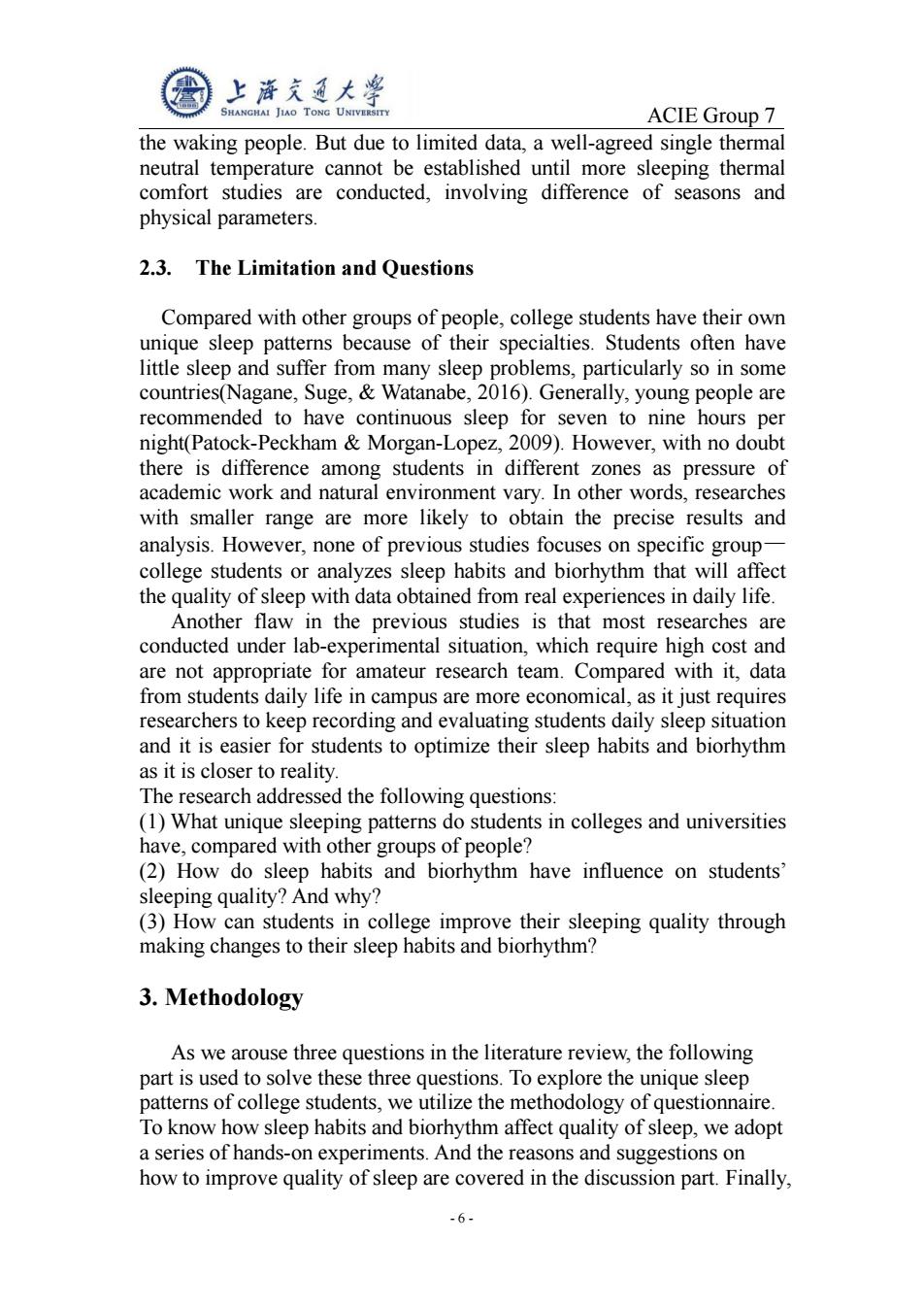正在加载图片...

上究豆大学 SHANGHAI JIAO TONG UNIVERSIT ACIE Group 7 the waking people.But due to limited data,a well-agreed single thermal neutral temperature cannot be established until more sleeping thermal comfort studies are conducted,involving difference of seasons and physical parameters. 2.3.The Limitation and Questions Compared with other groups of people,college students have their own unique sleep patterns because of their specialties.Students often have little sleep and suffer from many sleep problems,particularly so in some countries(Nagane,Suge,Watanabe,2016).Generally,young people are recommended to have continuous sleep for seven to nine hours per night(Patock-Peckham Morgan-Lopez,2009).However,with no doubt there is difference among students in different zones as pressure of academic work and natural environment vary.In other words,researches with smaller range are more likely to obtain the precise results and analysis.However,none of previous studies focuses on specific group- college students or analyzes sleep habits and biorhythm that will affect the quality of sleep with data obtained from real experiences in daily life. Another flaw in the previous studies is that most researches are conducted under lab-experimental situation,which require high cost and are not appropriate for amateur research team.Compared with it,data from students daily life in campus are more economical,as it just requires researchers to keep recording and evaluating students daily sleep situation and it is easier for students to optimize their sleep habits and biorhythm as it is closer to reality. The research addressed the following questions: (1)What unique sleeping patterns do students in colleges and universities have,compared with other groups of people? (2)How do sleep habits and biorhythm have influence on students' sleeping quality?And why? (3)How can students in college improve their sleeping quality through making changes to their sleep habits and biorhythm? 3.Methodology As we arouse three questions in the literature review,the following part is used to solve these three questions.To explore the unique sleep patterns of college students,we utilize the methodology of questionnaire. To know how sleep habits and biorhythm affect quality of sleep,we adopt a series of hands-on experiments.And the reasons and suggestions on how to improve quality of sleep are covered in the discussion part.Finally, -6-ACIE Group 7 - 6 - the waking people. But due to limited data, a well-agreed single thermal neutral temperature cannot be established until more sleeping thermal comfort studies are conducted, involving difference of seasons and physical parameters. 2.3. The Limitation and Questions Compared with other groups of people, college students have their own unique sleep patterns because of their specialties. Students often have little sleep and suffer from many sleep problems, particularly so in some countries(Nagane, Suge, & Watanabe, 2016). Generally, young people are recommended to have continuous sleep for seven to nine hours per night(Patock-Peckham & Morgan-Lopez, 2009). However, with no doubt there is difference among students in different zones as pressure of academic work and natural environment vary. In other words, researches with smaller range are more likely to obtain the precise results and analysis. However, none of previous studies focuses on specific group— college students or analyzes sleep habits and biorhythm that will affect the quality of sleep with data obtained from real experiences in daily life. Another flaw in the previous studies is that most researches are conducted under lab-experimental situation, which require high cost and are not appropriate for amateur research team. Compared with it, data from students daily life in campus are more economical, as it just requires researchers to keep recording and evaluating students daily sleep situation and it is easier for students to optimize their sleep habits and biorhythm as it is closer to reality. The research addressed the following questions: (1) What unique sleeping patterns do students in colleges and universities have, compared with other groups of people? (2) How do sleep habits and biorhythm have influence on students’ sleeping quality? And why? (3) How can students in college improve their sleeping quality through making changes to their sleep habits and biorhythm? 3. Methodology As we arouse three questions in the literature review, the following part is used to solve these three questions. To explore the unique sleep patterns of college students, we utilize the methodology of questionnaire. To know how sleep habits and biorhythm affect quality of sleep, we adopt a series of hands-on experiments. And the reasons and suggestions on how to improve quality of sleep are covered in the discussion part. Finally